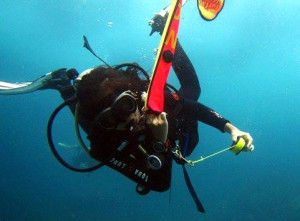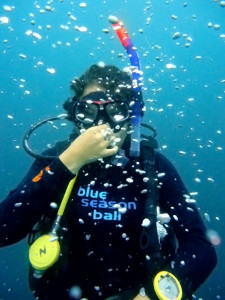This entry is part 2 of 2 in the series Understanding and improving your air consumption
 Hi again,
Hi again,
So last time we looked at misconceptions regarding air consumption and the factors which you can’t change. In this second installment I’m going to share my thoughts on how you actually can improve your use of air underwater. This is the same advice I give to our professional interns here in Blue Season Bali and I’ve seen dramatic improvements amongst our Divemaster trainees as a result of applying them.
The root cause of unnecessary air consumption is that you are working more underwater than you need to and/or have poor control of your breath cycle. Specifically then, these are the areas you should have a look at:
Buoyancy: Control of your buoyancy is an art and one which you will continue to refine throughout your diving career. Good buoyancy is good diving and is critical to being comfortable in your scuba gear underwater. Without good buoyancy you will constantly be fighting your equipment and environment which will result in more air consumption. Remember the fundamentals of your Open Water course. Pay close attention to changes in your depth and either add or release air as necessary. Once you’re neutral at a given depth the rest comes from your breathing and lungs. Practice being as still as possible in the water and just controlling your depth using your breathing. Tune into your buoyancy. Floating up a bit? No worries, just time to exhale a bit more…About to hit the bottom? No worries, just inhale a bit. Remember that every movement you make with your body costs you more air out of that tank. Minimise movement by controlling buoyancy as much as possible through the air in your BCD and your lungs. And of course as a result of this you get to feel that awesome ‘floating in space’ experience!
Trim: Unnecessary drag equals more work for you which equals more air consumption. See yourself as a Formula 1 car underwater and remove all unnecessary drag – you should be as streamlined as possible with all gauges tucked in, as little as possible hanging from your BCD (you are not a Christmas tree!) and in a nice horizontal body position. Next, check your weighting. At the end of your next dive, hold your breath at the surface then release all the air from your BCD. If you’re properly weighted, you should float at eye level. My guess is you’re wearing too much weight, probably as a security blanket left over from your Open Water course. Get rid of any excess weight, you’re the one who has to work harder dragging it around underwater. If you have more than one wetsuit, repeat the process for each so that you know your optimal weight and wetsuit configurations for each one.



